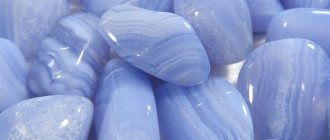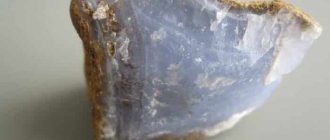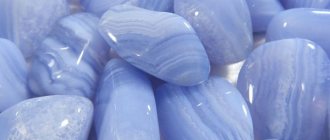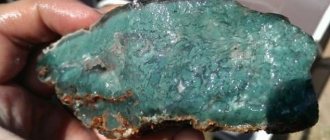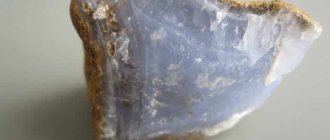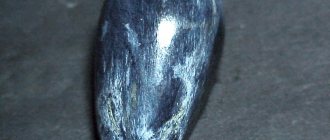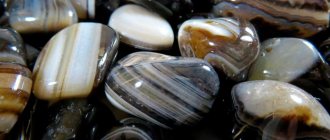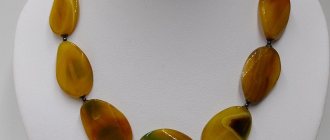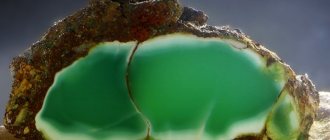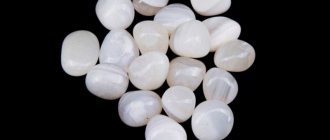Chalcedony is a translucent variety of quartz that comes in a variety of colors. It forms sinter masses, veins and crusts. The mineral has several varieties and shades. Chalcedony stone is actively used in the jewelry industry, and people consider this mineral the patron saint of love.
Story
Chalcedony has been known to people since ancient times.
In Ancient Greece, beautiful stones that could be processed were highly valued. Sometimes wars broke out over the possession of mines. In the ancient Greek city of Chalkindon, which stood on the shores of the Sea of Marmara in Asia Minor (now part of Turkey), a deposit of a beautiful variety of quartz was discovered.
The stone was called "chalcedony". It amazed with its richness of colors and shades. Ancient Greek stone carvers began to create amazing stone jewelry - gems. Miniature relief images of people, animals, birds, everyday and military scenes were carved on stone cabochons.
Cameo - this is what they began to call images in the convex technique, and intaglio (seals) - in the in-depth technique.
Red, orange, blue and other colored varieties of chalcedony were usually used to make gems.
After the conquest of the ancient world by the barbarians, the popularity of such jewelry disappeared. Interest in chalcedony returned in the era of classicism, after archaeologists found chalcedony gems during excavations in Roman cities. Noble people wore jewelry in which these ancient glyptic works were inserted.
In subsequent periods of history, interest in such products did not fade away. European monarchs possessed large collections of glyptic works.
The Hermitage collection, which included many thousands of stones made by ancient and modern carvers, acquired particular fame.
It is known that Napoleon had a ring made of chalcedony, Byron too, and Pushkin had two rings with carnelian (a type of chalcedony).
Chalcedony became a kind of symbol of Russian poetry at the beginning of the 20th century . The poet Maximilian Voloshin, who lived in Koktebel, loved collecting colored chalcedony on the sea coast. He gave them to writers and poets who visited his hospitable home.
What is chalcedony
This stone is a type of quartz. It itself has more than a hundred varieties, the physical and chemical characteristics of which are similar (except for the color palette).
Physicochemical characteristics
- Chemical formula - SiO2 .
- Color - yellow, blue, gray; varieties have other colors.
- Gloss - matte, waxy.
- Transparency - cloudy, translucent at the edges, translucent.
- Hardness - 6,5–7.
- Density - 2.58–2.64 g / cm3 .
Due to complex geological processes in the earth's crust and the presence of impurities, this mineral may look different, but the physical and chemical characteristics remain the same.
The stone is distinguished by its porosity and cryptocrystalline structure. Texture: fine fiber.
The mineral forms:
- solid massifs;
- spherulites and spherulitic crusts with a kidney-shaped surface;
- pseudostalactites;
- veins.
Varieties
This mineral has more than a hundred of them. The varieties have different colors, but their chemical formula is the same.
The most famous varieties of chalcedony:
- Agate (banded and also single-colored). Banded agate has layers of different color, density and transparency. Some specimens do not have layers, but have a pattern: star-shaped, mossy, etc.
Banded agate
- Heliotrope is a dark green stone with red spots and stripes. If the inclusions are yellow, it is plasma - a type of heliotrope.
Heliotrope
- Carnelian - its color range is red-yellow-brown.
Cornelian
- Onyx is a stone with pronounced layers: red-brown-yellow, white and black patterns may be present. The transition from one color to another is smooth.
Onyx
- Chrysoprase is a precious variety of chalcedony. This green chalcedony is valued for its color rather than its pattern or pattern like other varieties.
Chrysoprase
- Cacholong is an opaque stone of milky white color with various shades. This is what chalcedony cacholong looks like. White cacholong without shades is considered not a variety of chalcedony, but of opal.
Cacholong
Varieties
The mineral is unique in that it has several varieties that differ from each other in origin, composition and color. Chalcedony geode, in most cases, consists of small crystals.
Varieties also include: mtorolite, carnelian, sapphirine, cacholong, heliotrope and many others. Each stone has certain abilities and, according to some claims, is endowed with magical powers.
The most famous types of chalcedony are:
- jasper - has an interesting yellow color;
- endrigus - white chalcedony (sometimes translucent), very often used in the jewelry industry due to its unique structure;
- chalcedony onyx - has a red tint with striped inclusions;
- agate - has a purple or blue tint, the saturation of which depends on the level of quartz ingrowth;
- chrysoprase - has a fine crystalline structure, the green color is acquired due to the high nickel content.
Place of Birth
Chalcedony is mined in many countries. Rich deposits are located:
- in India;
- Brazil;
- Uruguay;
- Sri Lanka;
- Scotland;
- Italy;
- Poland;
- Czech Republic;
- Germany;
- Australia;
- Transcaucasia;
- in Madagascar.
In Russia, the mineral is found in many areas: Primorye, Moscow region, Crimea, the Urals, Chukotka.
Blue chalcedony can be found on the Black Sea coast, on the banks and in the valleys of the Yenisei and Lena.
Form of being in nature
Aggregates
Sinter formations.
Uruguay Chalcedony forms dense masses, sintered forms, nodules, crusts, and fills voids. The mineral occurs in the form of crusts with an irregularly rounded, kidney-shaped or warty surface. It also forms sinter masses in cavities, stalactites, gradually turning into cluster-shaped and irregular sheet-like accumulations. This mineral is also observed in the form of individual kidney-shaped irregular or rounded nodules, formed either by concretion or as a result of weathering of rocks in which there were cavities filled with chalcedony. Sometimes it composes slag-like marsas, as well as small veins or cement in rocks. Usually he makes geodes and creates amygdaloidal voids in altered basic igneous rocks; These chalcedony inclusions are often hollow and may contain liquid that has been plugged during crystallization. Minerals often form encrusting pseudomorphs on other minerals, especially calcite and fluorite, and also replace these and other minerals and fossil shells. The term “chalcedonic silica” has a broader meaning than chalcedony, which mainly refers to crustification formations and products of filling voids, represented by any fine-grained variety of quartz with a fibrous microstructure. This term is applied to continuous and nodular formations of primary sedimentary or diagenetic origin, including cherts and cherts, as well as accumulations resulting from the replacement of limestone and other rocks.
In chalcedony, more or less clearly visible banding is visible, parallel to the outer surface of the formations or the walls of the cavity. This banding is not always visible to the naked eye, but can be detected under a microscope in thin sections oriented perpendicular to the outer surface of the clusters, or it can be revealed by staining and etching.
Application
Colored chalcedony are jewelry and ornamental stones, and chrysoprase, according to the classification of E. Ya. Kievlenko, belongs to jewelry (precious) stones.
These minerals are used to make various jewelry and stones.
Ornamental types of chalcedony are used for the manufacture of decorative and household products: vases, figurines, frames for mirrors and paintings, furniture inlay.
Onyx is used as an excellent material for lampshades and stained glass.
Collectors value chalcedony specimens that have distinct kidney-shaped and stalactite-like shapes.
Recommendations for caring for minerals
When buying products with a semi-precious stone, every person wants it to remain in its original form for as long as possible. This is not so difficult to do, especially if you know the rules for caring for the mineral.
Most often, the stone becomes dull and dirty in areas of constant contact with the skin. The product should be washed regularly under warm running water and soapy water. It is better to remove traces of dirt and grease with a soft sponge rather than with a hard brush, which can damage the surface of the jewelry.
Chalcedony should not come into contact with cosmetics, this applies to various creams and perfumes.
Medicinal properties
Chalcedony, depending on the type and color, can have different effects on health. For example, green and blue chalcedony are beneficial for the nervous system. It has a calming effect, relieves depression, emotional excitability, improves sleep, and improves mood.
The use of the healing properties of the stone is only an additional means in the treatment of diseases.
Main medicinal properties of varieties
When treating and preventing diseases, you need to take into account the type of chalcedony:
- Carnelian promotes healthy skin, gastrointestinal tract, and strengthens the immune system. People with cancer cannot use it.
Before using the healing properties of carnelian, it is recommended to be checked for the presence of oncological pathology.
- Heliotrope normalizes blood pressure and heart function.
- Onyx harmonizes the functioning of organs, improving health.
- Chrysoprase helps with weather dependence, visual impairment, and relieves nervous tension.
- Agate stabilizes the psyche and strengthens the immune system.
- Kacholong normalizes the nervous system and improves metabolism in the body.
Safety precautions during treatment
You should not constantly, without breaks, wear products made of chalcedony and its varieties, so as not to impair blood circulation and cause unreasonable fears.
Carnelian is slightly radioactive, but such a small natural radiation does not harm a person, but, on the contrary, helps recovery (if he does not have cancer).
Carnelian should not be used by people with cancer.
Before you start using the medicinal properties of this variety of chalcedony, it is better to check for the presence of cancer pathology.
STRUCTURE
The structure of chalcedony is a hidden system, which “walks” from trigonal to aggregative. This makes the stone universal in its own way, but at the same time very multidirectional. The syngony is trigonal, where, depending on the arrangement of the fibers, their parallelism and perpendicularity, as well as aggregate compression, different coordination of molecules occurs, which creates various geometric complexes inside.
The crystal structure of chalcedony, like other polymorphic modifications of quartz, is characterized by the peculiarity that the Si4+ ion is always in a quadruple environment of O2- ions located at the vertices of the tetrahedron. Each vertex of such a tetrahedron simultaneously serves as the vertex of another adjacent tetrahedron. Thus, the crystal lattices of these minerals consist, as it were, of frameworks of tetrahedrons linked to each other. The method of coupling in all modifications is the same (through the vertices of tetrahedrons), but the orientation and general symmetry in their arrangement are different. In general, the packing of oxygen ions is not dense: in the frameworks there are “voids” between the tetrahedra. In low-temperature modifications they are small in size, and in high-temperature, more “loosely” constructed modifications they are larger.
Magic properties
Chalcedony has many varieties. Each of them has a certain magical power, but there are also magical qualities common to them.
General magical properties
Chalcedony has long been valued as a talisman against any negativity directed at its owner. To protect against evil forces, the untreated pebble was worn close to the body and not shown to anyone.
Ancient Greek sailors took such a stone on a voyage so that it would protect against dangers and help them return home.
The Mongols revered this mineral because they believed that it protected both people and their homes from dark forces. They believed that chalcedony absorbs the owner’s melancholy and sadness, and in return gives him joy and vitality. They considered pink chalcedony to be a stone that brings good luck.
In ancient times, chalcedony was called the “stone of love,” as its owner became very attractive to men and found her one and only.
It was also called the “stone of joy” because it dispels sadness.
The chalcedony talisman helps only people with a pure soul and bright thoughts.
It is believed that the energy of bright stones is the strongest.
A wonderful family amulet is untreated chalcedony. He protects peace and happiness in the family.
The chalcedony talisman helps to be successful in both business and personal life, improves memory, and sharpens the mind.
This stone balances the flow of vital energy, neutralizes aggression, transforming it into positive energy.
Chalcedony is of particular importance for people experiencing difficult to solve problems. Under the influence of the powerful energy of the stone, its owner will become wiser, stronger and overcome difficulties.
The main magical properties of chalcedony varieties
Each type of this stone has not only general properties, but also individual ones.
Heliotrope increases vitality and determination, but a person can become fixated on one grandiose idea, become its fanatics and not pay attention to loved ones. To avoid such a distortion and to ensure that the owner’s personality develops harmoniously, the stone does not need to be worn all the time, but only for important meetings, etc.
Onyx is a stone for strong personalities who are not afraid of responsibility. It helps to make progress in public speaking and improves memory. A person becomes more purposeful and self-confident.
Carnelian is an effective amulet against any negative influence from the outside. The stone increases the owner’s vitality and helps to gain a positive attitude.
Chrysoprase has a special meaning for a person who is confused in his actions and feelings. The pebble will help develop intuition so that its owner in difficult situations can make the right decision. The owner of the gem should try to correct the negative qualities of his character, since chrysoprase can enhance not only the positive qualities of a person, but also negative ones.
Cacholong promotes a happy family life and is considered an effective amulet for women.
Agate - increases creativity, sharpens the mind, and is one of the most effective amulets.
Talismans and amulets
Chalcedony Sarder
Chalcedony has long been considered the patron saint of scientists. It helps them “gnaw the granite of science,” make discoveries, analyze, remember and process information. Therefore, students and teachers, researchers, professors and other scientists should stock up on a talisman with this stone.
In Ancient Mesopotamia and Assyria, chalcedony amulets were made in cylindrical shapes and religious inscriptions were applied to them.
Chalcedony is a stone of the earth, with which it is closely connected energetically. Therefore, in ancient times, sailors tried to stock up on pebbles when setting off on long voyages. They believed that he would help them return to their native land. Today, this property of the stone is relevant for those whose work involves swimming, as well as for sea travelers.
Agate Botswana
Agates are powerful amulets for children. They protect them from falls, bruises and all kinds of injuries, as well as from the evil eye.
Single women need chalcedony to attract a soul mate. It enhances their natural magnetism so that no man can resist. The stone helps to choose “the one” for life among many applicants.
Actors should stock up on orange chalcedony. It will enhance their abilities and help them get used to the role.
Raw chalcedony, even a very small one, can become a real talisman for married couples. He will remain faithful in the family, help feelings never fade, and help spouses become good parents.
Of all the men, Sergeev especially singles out chalcedony. He will help them in absolutely all endeavors, and will also make them wiser, calmer, more patient and courageous.
Among women, the stone distinguishes the owners of the following names - Valeria (love, harmony in the family) and Oksana (joy of life, no gloomy thoughts), Inga (protection from negativity, supply of energy), Ksenia (getting rid of melancholy, desire to start a new life) and Irina (getting rid of loneliness, new love).
Who is suitable according to their zodiac sign?
Chalcedony, according to astrologers, according to the horoscope, is ideal for people born under the signs of Sagittarius and Cancer .
- Sagittarius will immediately feel energy recharge and self-confidence from this stone, so they will successfully cope with negative emotions. The energy of the mineral will help its owner overcome obstacles to his goals. Thanks to the magic of chalcedony, Sagittarius will be successful in business and happy in his personal life. Of the varieties of chalcedony, agate and blue agate are not suitable for Sagittarius.
- Chalcedony gives strong protection to Cancer Women born under this constellation, thanks to the magic of the stone, will increase their charm many times over. Ideal for Cancer: heliotrope, agate, blue agate, cacholong.
- Geminis become balanced. A person will determine the main tasks for himself and will carry them out without wasting time on small matters. The following varieties can become lucky stones for Gemini: carnelian, chrysoprase, agate, blue agate, cacholong. Wearing onyx is not recommended.
- With the help of this stone, Leo Agate is especially suitable for Leo.
- Virgo will find it easier to establish relationships with others, and her health will improve. Carnelian and agate are ideal for Virgo.
- Capricorn overcome financial problems, which will improve their financial situation.
Chalcedony is also suitable for the rest of the zodiac signs, but the following varieties should not be worn:
- Aries - chrysoprase, agate, cacholong.
- For Scorpio - carnelian, chrysoprase, cacholong.
Some varieties are ideal for the following zodiac signs:
- for Sagittarius - agate, cacholong;
- for Libra - blue agate, cacholong;
- for Aquarius - blue agate;
- for Pisces - cacholong, blue agate.
Compatibility with other stones
To determine the compatibility of stones, you can use one of the systems. The easiest way to follow is the one that allows you to carry minerals related to the friendly elements: Earth and Water, Air and Fire.
Chalcedony belongs to the element of Earth, therefore, jewelry made from it can be worn with stones of the elements of Earth and Water, for example, turquoise, jasper, aquamarine, chrysocolla, etc.
It is not recommended to wear chalcedony with minerals of the elements of Air and Fire, for example, uvarovite, rauchtopaz, coral, garnet.
The following varieties of chalcedony also belong to the element of Earth: agate, onyx, cacholong. Chrysoprase and blue agate belong to the element of Air. Heliotrope - to the element of Water, and carnelian - to the element of Fire. “Neighbors” for these stones should be selected taking into account the compatibility of their elements.
Read also : Serpentine - a stone for strong -willed people
Variegated mix
The magical energy of a gem depends on the color. The brighter it is, the stronger the stone.
In ancient India and China, thick black agate was obtained by soaking the stone in a solution of honey and then calcining it over a fire.
For the Mongols, true (blue and gray) chalcedony were stones of joy, but their main task was protection from the evil eye and damage. But the ancient Greeks did not go on sea voyages without a chalcedony amulet.
Esotericists believe that unprocessed chalcedony has great magical potential. Processing the stone “cuts off” part of the magical power of the gem.
By the way, he was the Bishop of Rennes and was an anti-feminist. He considered women envious, greedy, gluttonous, lustful...
In Marbod's Lapidarium we read:
“The stone is chalcedony, which glistens with dull whiteness...
They wear a drilled stone on their finger or around their neck;
The one who wears it, they say, wins in the courts.”
How to care
Chalcedony and products made from it should be protected:
- from chemicals;
- sudden changes in temperature;
- high temperatures, direct sunlight (otherwise chrysoprase and agates may become discolored).
Cacholong and blue agate should be protected from water. Cacholong should be wiped from time to time with a soft woolen cloth soaked in high-quality olive oil.
Before physical exercise or physical work, jewelry should be removed, as chalcedony can be easily scratched.
You need to clean the stone with a warm soapy solution and a cloth, then rinse with clean water.
Steam and ultrasonic cleaning cannot be used for chalcedony.
This mineral should be stored separately from other stones or wrapped so that harder stones do not damage it.
Chemical composition
Chalcedony contains 90-99% SiO2, with the highest silica contents characteristic of light-colored and milky white varieties. In addition to silica, the mineral contains H2O and variable amounts of Fe2O3, Al2O3 and other impurities. Relatively high Fe2O3 content is observed in brown and reddish-brown varieties. The water in it is not crystallization, but is retained by capillary and adsorption forces. Studying the stone using infrared spectrometry shows that it also contains an (OH) group. Hydroxyl (OH) can replace oxygen in SiO4 tetrahedra located in deformed and disordered areas between adjacent interlocking fibers. Hydroxyl can also be included in the internal structure of the fibers; similar substitutions have been established in coarse-crystalline quartz. A significant part of the water is lost when the mineral is dried at room temperature or when heated to a temperature of about 100 ° C. It is believed that the water is located in open interconnected channels or spaces between the fibers. These channels have microscopic or submicroscopic dimensions. Molecular water can also be present in closed pores, in which case it is released only at higher temperatures of the order of 350-800° along with water bound in the form of (OH). The loss of water is accompanied by a decrease in refractive index and specific gravity. During dehydration at low temperatures, the decrease in refractive index No usually does not exceed 0.005.
How to distinguish from a fake
Knowing the physical characteristics of chalcedony will help you determine whether it is an imitation or a real stone:
- Weight. The mineral is heavier than fake plastic and glass.
- Thermal conductivity. In your hands, the stone heats up very slowly, unlike glass and plastic.
- Color. Natural chalcedony has uneven coloring, there are defects and inclusions. The colors are calm, gentle, the shades are hazy, the shine is dim.
Signs of fake beads:
- identical patterns;
- same shade;
- Perfectly the same size.
We check for authenticity
It just seems like there is no point in counterfeiting an affordable gem. But in fact, among jewelry with chalcedony, fakes are also often found.
If you take care of blue agate jewelry regularly, the process will not take much time.
How to recognize a fake:
- When choosing a stone without a frame, pay attention to its weight. Too light? Fake. Does it heat up quickly in your palms? Well, most likely, you are holding ordinary plastic in your hands. Possibly glass.
- When there is metal in the jewelry in addition to stone, it becomes more difficult to focus on weight. In this case, it is recommended to take a closer look at it. A real stone should not have bubbles.
- In this case, the gem can have various inclusions. A real mineral has smooth transitions, colors can be bright, but not too sharp.
After seeing what chalcedony looks like, ask the seller for documentation on the product. It is better if you familiarize yourself in advance with what such certificates should look like, so that they do not slip you a piece of paper as a distraction.
Best time to buy
It is believed that if you buy a stone on a certain lunar day, its healing and magical properties will be stronger. A favorable time for purchasing chalcedony is the 16th lunar day , and it is better to start using it on 1-2 lunar days (but pink chalcedony has its own favorable lunar days - the 19th and 5th, respectively ). The best time to purchase varieties of this mineral is indicated in the table.
Table of lunar days of acquisition and accession of chalcedony varieties
| Name of the stone | Acquisition (lunar day) | Accession (lunar day) |
| Agate | 29/30 | 15/18 |
| Heliotrope | 21 | 7 |
| Onyx | 5 | 19 |
| Cacholong | 18 | 4 |
| Cornelian | 25 | 11 |
| Chrysoprase | 28 | 14 |
There is another opinion about agate. Some believe that it is insensitive to the lunar cycle and advise buying it on Monday, Tuesday, Thursday (and blue agate - on Monday morning, in the spring).
Price
Chalcedony is not a very expensive stone, for example, yellow chalcedony (1.5 cm tumbling) costs 50 rubles. The cost of its varieties varies. For example:
- pendulum pendant (made of carnelian) - 105 rub. ;
- pyramid made of dark onyx (4 cm) - 172 rubles. ;
- heliotrope pendant - 290 rubles ;
- keychain with cacholong - 300 rub. ;
- tumbling (blue chalcedony) (2.5 x 3 cm) - 420 rub. for 1 piece ;
- Moss agate cabochon (62 x 43 x 4 mm) - 800 rub. ;
- chrysoprase bracelet (gilded jewelry) - 2,000 rubles.
Jewelry with mineral
Chalcedony is considered an ornamental stone. All types of gems are beautiful in their own way, common in nature and, accordingly, very affordable. Chalcedony is used to make beautiful, inexpensive jewelry. If we talk about jewelry made of silver or gold, the price will be much higher:
- The price of a silver ring starts from 5 thousand rubles, while a gold one can cost 3–5 times more, depending on the accompanying inserts. If we are talking about luxury jewelry with a rare type of agate, for example, moss agate, then the price can reach 100 thousand or more.
- Earrings made of silver can be purchased from 3 thousand rubles; gold, accordingly, costs more.
- A silver pendant is estimated at 2 thousand rubles, but can reach 20 thousand.
- Bracelets start from 5 thousand for silver.
As for simple beads and bracelets made of chalcedony cabochons, the price starts at 300 rubles for a bracelet and from 500 rubles for beads. The main thing is to be able to distinguish a natural mineral from plastic or glass.
